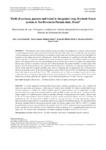Please use this identifier to cite or link to this item:
http://www.alice.cnptia.embrapa.br/alice/handle/doc/997804| Title: | Yield of soybean, pasture and wood in integrated crop-livestock-forest system in Northwestern Paraná state, Brazil. |
| Authors: | FRANCHINI, J. C.  BALBINOT JUNIOR, A. A.   SICHIERI, F. R.   DEBIASI, H.   CONTE, O.   |
| Affiliation: | JULIO CEZAR FRANCHINI DOS SANTOS, CNPSO; ALVADI ANTONIO BALBINOT JUNIOR, CNPSO; FERNANDO RIBEIRO SICHIERI, Fartura Consultoria; HENRIQUE DEBIASI, CNPSO; OSMAR CONTE, CNPSO. |
| Date Issued: | 2014 |
| Citation: | Revista Ciência Agronômica, Fortaleza, v. 45, n. 5 (Especial), p. 1006-1013, 2014. |
| Description: | ABSTRACT: The integrated crop- livestock-forest system can enhance the production of soybeans, meat and wood in regions characterized by sandy soils and warm climate. The aim of this study was to evaluate the yield of soybean, Urochloa ruziziensis grass and eucalyptus in an integrated system during the first four years after the establishment of eucalyptus in the northwestern region of Paraná state, Brazil. The experiment was established in October 2009, using soybean (summer) -U. ruziziensis (autumn/winter) succession between single rows of Corymbia maculata (eucalyptus species). The spacing between tree rows and eucalyptus plants in the row were 14 and 4.2 m, respectively. Adjacent plots had the same soybean-U. ruziziensis succession, but without eucalyptus. The spatial variability of soybean grain yields and grass shoot dry matter production was evaluated with and without trees, and the data was analyzed using geostatistics, with the results expressed as spatial variability maps. The tree component did not significantly affect soybean yield in the first two growing seasons. In the 3rd and 4th growing season (2011/12 and 2012/13), the interference of eucalyptus reduced the soybean grain yield by 2.9 and 27.0%, respectively, and the effect was stronger close to the tree rows. In July 2012, the tree component reduced the shoot dry matter productivity of U. ruziziensis by 29.2%. At 19 and 35 months after eucalyptus planting, the cumulative wood volume production was 0.73 and 5.17 m3 ha-1, respectively. RESUMO: O sistema integração lavoura-pecuária-floresta pode viabilizar a produção de soja, carne e madeira em regiões que apresentam solos arenosos e clima quente. O objetivo desse trabalho foi avaliar a produtividade de soja, Urochloa ruziziensis e eucalipto em sistema integrado, durante os quatro primeiros anos de implantação, na região Noroeste do Paraná. O experimento foi implantado em outubro de 2009, usando a sucessão soja-U. ruziziensis nos entre renques simples de Corymbia maculata (espécie de eucalipto utilizada). Os espaçamentos entre renques e plantas foram de 14 e 4,2 m, respectivamente. Em área contígua, foi usada a mesma sucessão de culturas, mas sem o eucalipto. Os rendimentos de soja e de capim foram avaliados na ausência e presença de árvores, de forma espacializada, sendo os dados analisados por geoestatística e os resultados expressos por mapas de variabilidade espacial. O componente arbóreo não afetou a produtividade de soja nas duas primeiras safras. Na terceira e quarta safras, 2011/12 e 2012/13, a redução de produtividade ocasionada pela interferência do eucalipto foi de 2,9 e 27,0%, sendo mais intensa nas proximidades das árvores. Em julho de 2012, constatou-se que o componente arbóreo reduziu em 29,2% a produtividade de massa seca do capim. Aos 19 e 35 meses após a implantação, a produção acumulada de madeira foi de 0,73 e 5,17 m3 ha-1. |
| Thesagro: | Soja |
| ISSN: | 1806-6690 |
| Type of Material: | Artigo de periódico |
| Access: | openAccess |
| Appears in Collections: | Artigo em periódico indexado (CNPSO)  |
Files in This Item:
| File | Description | Size | Format | |
|---|---|---|---|---|
| YieldofsoybeanpastureandwoodinintegratedcroplivestockforestsysteminNorthwesternParanaStateBrazil.pdf | 143.84 kB | Adobe PDF |  View/Open |









